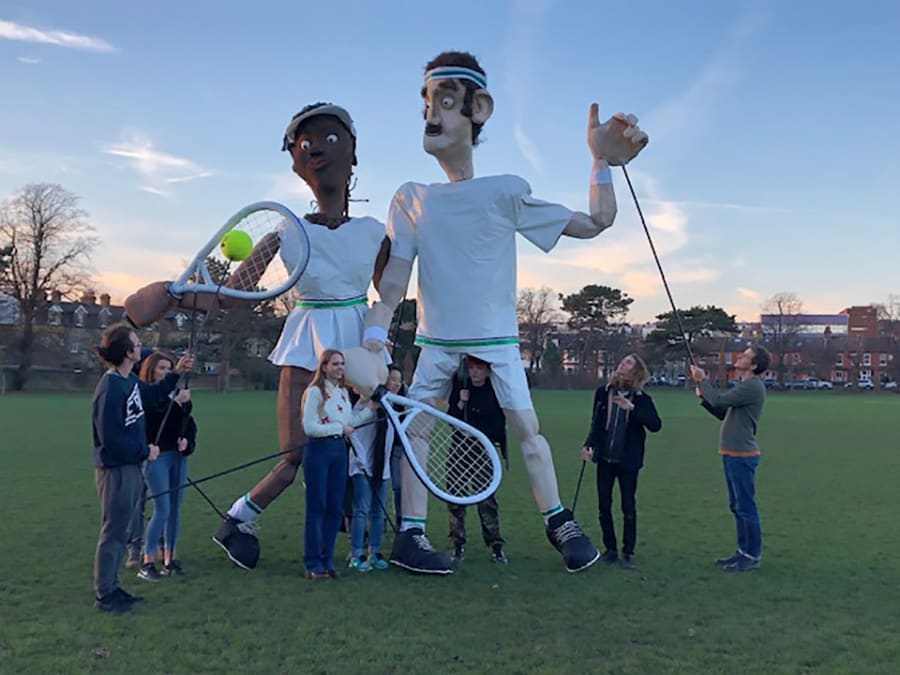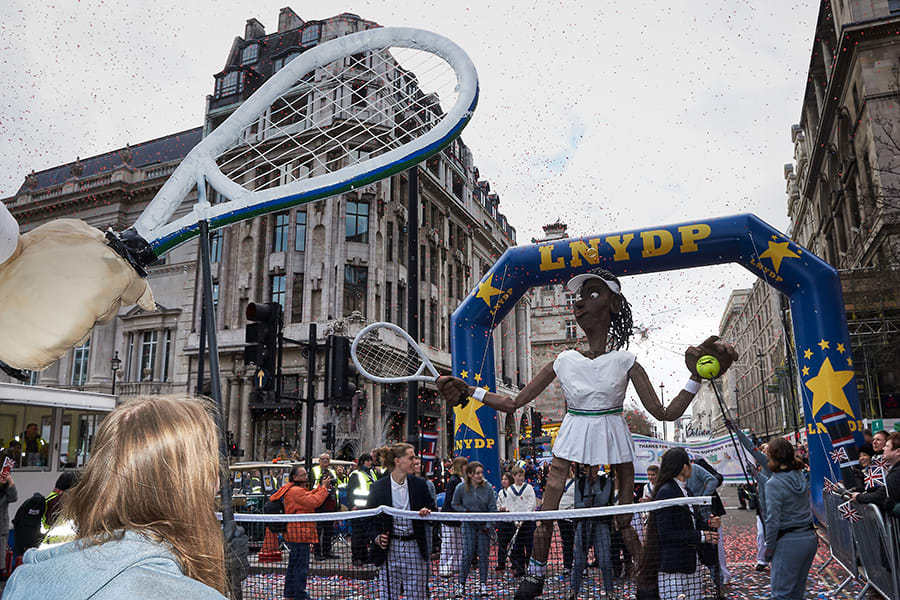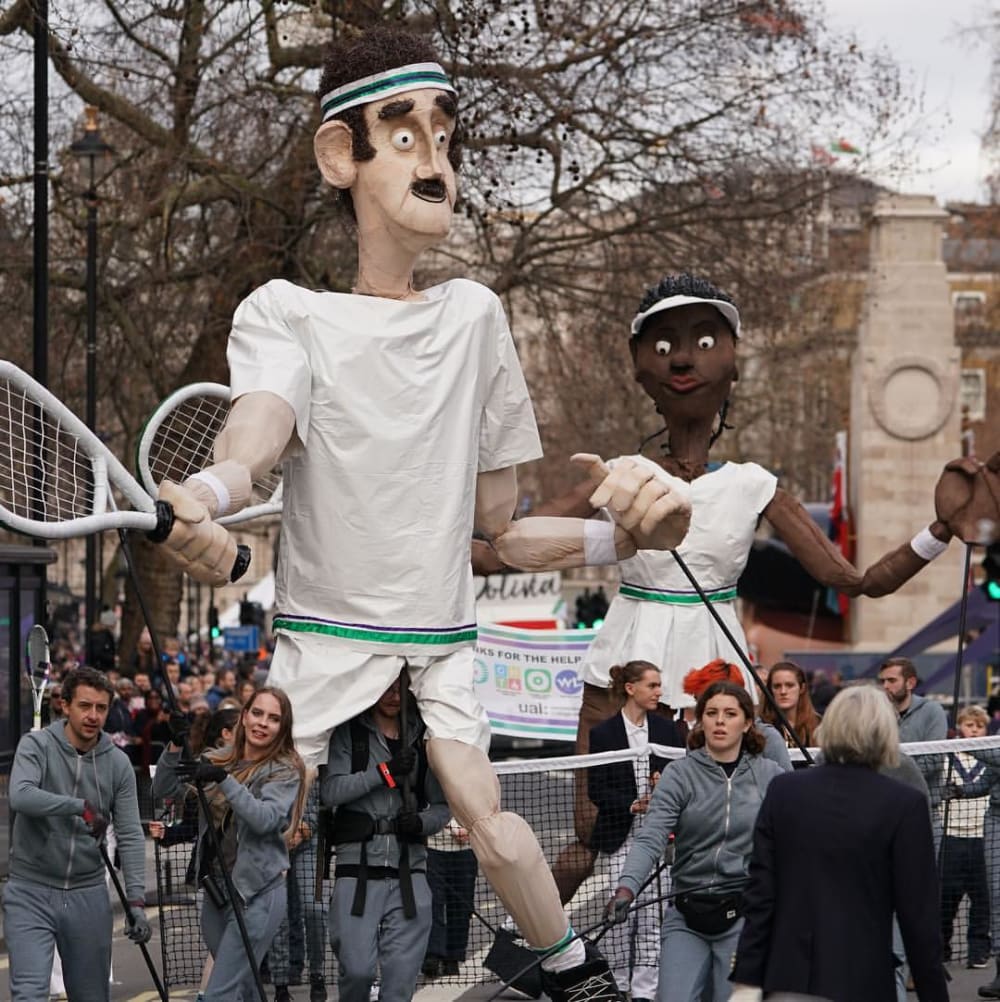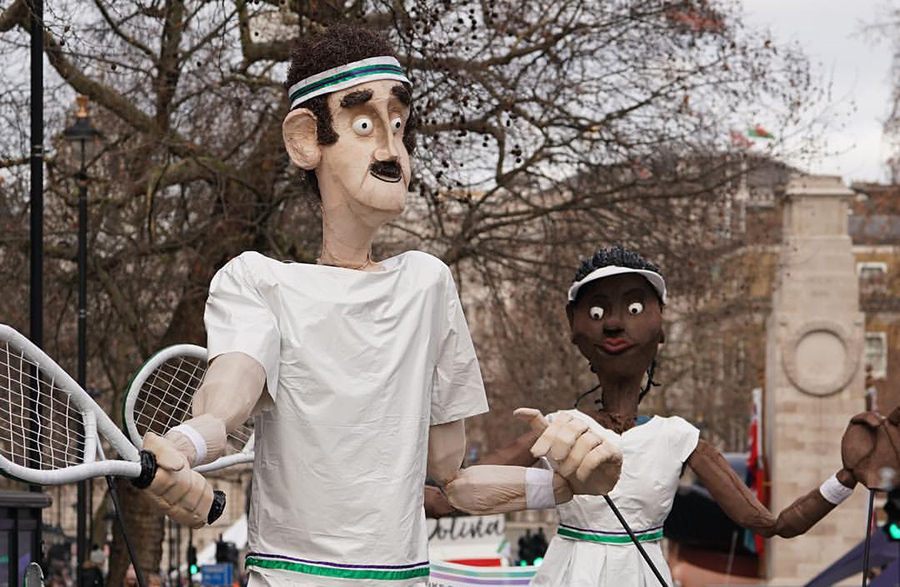London’s New Year’s Day Parade (LNYDP) is a huge event with global appeal that features more than 8,500 performers representing over 20 countries. Since 1987 it has raised millions of pounds for London charities and it is estimated that half a million spectators turn out to line the route, with an estimated global TV audience of 300 million tuning in!
All 32 London boroughs submit a float to the parade, which also usually include marching bands, cheerleaders, dancers and acrobats. However this year the London Borough of Merton (Wimbledon’s borough) approached students from BA Production Arts for Screen to design and create a pair of enormous tennis-player puppets in reference to the world-famous tennis championships held at Wimbledon each year.

, Wimbledon College of Arts, UAL
The students’ design impressed a panel of foreign ambassadors and high commissioners enough to score £5,000 for two local charities. The Mayor of Merton, Councillor Mary Curtin said: “We have been taking part in this competition for many years now and the effort that our talented team always put in is outstanding.
“I would like to thank everyone involved, with a special thanks to the students at Wimbledon College of Arts and Deputy Mayor, Councillor Geraldine Stanford for organising the Merton entry. Due to everyone’s efforts we’ve raised £5,000 for my two mayoral charities.”
Wimbledon’s prize-winning team was made up of Amelia Brown, Kira Kemp, Elliot Lidgey and Izzy Von Schmidt, who are all first year students on BA Production Arts for Screen.

, Wimbledon College of Arts, UAL
Amelia very kindly took the time to answer a few questions about how the students created their prize-winning entry.
Hi Amelia, well done for the win! Could you tell us a bit more about your fantastic entry and how you came to be involved?
Merton Council approached us with a rough idea of what they wanted and a brief that specified two 4 metre tall tennis players. They wanted the puppets to be different however produced to the same aesthetic. One was to be a white male and the other a black female. We were assigned a £2k budget and a deadline for 14 December 2018.
The puppets could either be stationary or walk, but the brief specified they must be able to move or interact in some way. We started the project in October in the second week of term, which, looking back was quite a commitment given it was so early on in our university lives.
Could you tell me about the research that you did to come up with your concepts?
We choose a Tim Burton cartoon style, as we wanted them to be likeable to suit the tone of the parade and appeal to its audience.
It is often possible to achieve quite high production standards with this style and as we were all quite inexperienced first year students we chose a design we thought we could impress with. We looked at many tennis players and previous puppets, including the puppets that appeared in Liverpool this year, which were all a big inspiration. We also looked at previous New Year’s Day parades, to get an idea of what techniques had been used before.

, Wimbledon College of Arts, UAL
Could you tell us about some of the stages involved in completing this project?
It’s important to add at this point that we could only spare time on Wednesdays and Saturdays for the project. For 9 weeks we split into groups; design, armature and body, textiles and costume, head and finally props e.g. tennis rackets.
This approach allowed us to use our time efficiently but as time went on we lost many of our team, as the project was such a large time commitment alongside our studies. This left us with a smaller, dedicated team to create the puppets and because of the depletion of team members we each had to take on a number of diverse roles in order to complete the puppets. This did however result in us all gaining a lot of skills from this project, which we wouldn’t have done otherwise.
Every Wednesday for the first few weeks we presented our work to the council and discussed the different options. Initially we felt it best to put the puppets on floats because of concerns about their weight. However after talking to a professional puppet maker we decided to put them on backpacks instead. We also decided to make the female more feminine in the face, by researching female face features in cartoons and animations.

, Wimbledon College of Arts, UAL
What were the major challenges that you experienced on this project and how did you address them?
Managing such a large team was one of the most difficult challenges. I found it difficult to coordinate everyone, not just students but also booking professionals, organising meetings with the council and the Colour House Theatre directors who usually manage this project for the council, and also other contractors. I also managed the finances, so keeping a track of budget and processing claims was sometimes quite challenging.
Another big challenge was compromising over different opinions about process and design. It was also quite difficult getting to grips with new techniques and materials, that many of us had never used before, like Plastazote, which is a versatile man-made polyethylene foam. We dealt with these issues by communicating regularly and taking advice from those with more experience, including teachers, professionals and students that had taken part in previous years.
We learnt that communication is always key, a lesson we had all seemed to forget as artists! We also learnt there must always be at least two main leaders to manage the team, motivate them, organise them and ensure all jobs get done, otherwise the groups struggles to stick to deadline and communicate with each other. And I personally learnt that it is very important to keep all parties in the loop and have regular meetings to update on progress, to ensure everyone is on the same page.
What do you think are the major takeaways from this project?
The biggest thing I learnt from this project is to take every opportunity offered to you, grab it and run with it!
Learn more about Wimbledon’s BA Production Arts for Screen.

